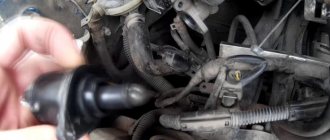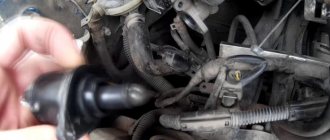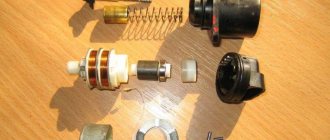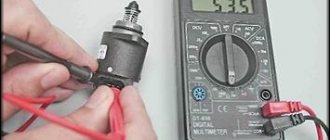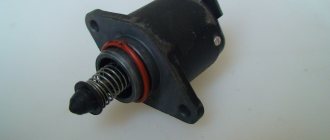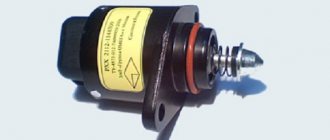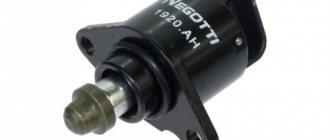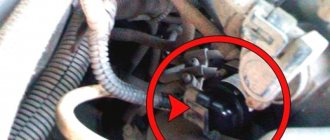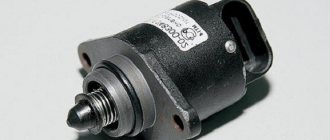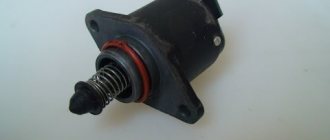Idle air control (IAC)
About a month ago I began to notice that the average fuel consumption had increased by a hundred.
Previously it was around 8.5 l/100 km, now it has risen to 10-10.5 l/100 km. I travel the same route all the time and at the same time, work and home. I also noticed that the IAC (idle speed control) began to “crackle”, the sound was similar to the crackling of a faulty bearing, at first it was the rollers. Yesterday I started cleaning it. It is easy to disassemble: 1. Unscrew the pxx sensor itself, do not disconnect the wires from it. 2. Unscrew the minus from the battery and turn on the ignition with the key. 3. Hold the sensor in one hand, and with the other hand connect the minus to the battery for a couple of seconds. The sensor begins to extend the rod, be careful, it may fly out under the action of the spring, so we hold it. 4. If you didn’t extend it all the way the first time, wait 10 seconds and connect the ground again. My sensor rod was covered in velvety black soot, I washed everything with VDshka, lubricated the rod itself and its threads and put it back together. I also cleaned the seat where the rod goes. Assembly and installation in the following order: 1. We put the bushing with the spring on the rod and screw it into the sensor until the end of the thread on the rod. 2. Scrolling the rod a little, we get the slots on the rod into the slots on the sensor. 3. Press on the rod (without fanaticism) and push it into the sensor until it stops. 4. Screw the sensor into place and put the block with wiring on it. 5. Turn on the ignition with the key (the negative battery is disconnected!) 6. Connect the negative battery for a couple of seconds, then disconnect it. We wait 5-6 seconds and repeat this operation a couple of times. The sensor rod will reach the required distance. 7. Connect the ground to the battery and you can try to start it. As a result of this operation: 1. The “chirping” sound of the IAC sensor has disappeared. 2. Consumption fell to the usual level, even became a little less than before. Today I was driving and brought along the same route only 7.6 liters per hundred. The day before yesterday at the same time and after resetting the BC in the same area it was 10.1 liters per hundred. I'm happy with the result! PS I didn’t take any photos, the camera on my phone is lousy, and I didn’t want to touch my camera with dirty hands. I am still tormented by the question: Where does carbon deposits, velvety dry and black, come from on the IRR rod? How can he get there? Through the intake valves, or perhaps to the return? This is what the soot looks like in this photo:
Popular in in-flight magazines
The most important thing is that when I received the product at the store, I received instructions on how to replace the IAC. It was a revelation for the master too.
I have attached instructions, I hope they will be useful.
The procedure for installing the idle air regulator 1. Remove the negative terminal from the battery (battery) 2. Remove the faulty regulator and install a new one in the reverse order 3. Connect the negative terminal of the battery (battery) 4. Insert the ignition key into the lock and turn until there will be glowing pictograms on the instrument panel (but do not start the car!) Carry out this procedure 3-5 times, and then start the engine in normal mode. If there is an increase in idle speed (which is sometimes possible when installing a new idle speed controller). Remove the terminals from the battery (battery) and wait 5-7 minutes, then perform steps 3.4 again.
Source
Idle air regulator Lada Largus 16 valves
During the operation of the car, in particular the Renault Logan, certain parts of the suspension, engine and fuel system fail. To ensure stable operation of the motor, it is necessary to diagnose and promptly eliminate emerging faults.
One of these malfunctions is unstable engine operation as a result of failure of the idle speed sensor or idle speed sensor. Below in the article, we will describe the signs of a sensor malfunction, the process of replacing it and calibration.
Reasons why a diesel engine stalls immediately after starting
fuel problem
The first thing a diesel owner should worry about if the engine immediately stalls after starting is the fuel level in the tank, as well as its fluidity. If the fuel in the tank is “at the bottom”, the engine will probably start on the remaining fuel in the line - but will not continue to work. The same applies to fuel freezing: paraffin clogs the fuel filter, and fuel stops flowing into the cylinder. Having exhausted the remaining fuel in the system, the engine stalls.
Or water got into the diesel fuel - condensation from the walls of the tank. In this case, it will also not be possible to prepare a mixture rich enough for stable operation of the engine.
To avoid such a problem, in winter you need to keep the tank as full as possible and choose a high-quality winter diesel fuel.
fuel line problem
If air gets into the fuel lines, due to the resulting plug, fuel will not be able to flow uninterruptedly into the cylinders.
A clogged fuel filter reduces the capacity of the fuel lines; as a result, the cylinders do not receive as much fuel as is necessary for normal diesel operation.
To prevent this problem, owners of diesel cars need to change the fuel filter before the onset of cold weather.
battery problem
One of the conditions for confident starting of modern diesel engines in cold weather is sufficient starting current from the battery during startup and powerful electrical support after. Energy-intensive systems such as a fuel pump, for example, require a sufficient battery charge level.
But in cold weather this is a problem. If a working starter has difficulty cranking the engine, this indicates that the battery is significantly discharged.
The solution is to charge the battery from a charger or at a service center, and replace the old tired battery with a new one.
problem with sensors
The idle speed regulator (sensor), IAC, supplies the required amount of air to the engine when it is not running under load and the throttle valve is closed. Thus, it regulates the stability of the internal combustion engine at idle. It also changes the engine idle speed depending on the degree of engine warming up: on a cold engine they are higher.
The amount of air that passes through the IAC is determined by the mass air flow sensor (MAF). The readings of the crankshaft position sensor (CPS), which determines engine speed depending on the load, also play a role.
Accordingly, if the IAC, DPKV and mass air flow sensors are faulty, the engine may start, but then stall due to incorrectly transmitted data to the ECU and errors in mixture preparation.
At the same time, in case of problems with the IAC, the “Check Engine” lamp does not light up, but a malfunction of the TPS throttle position sensor is accompanied by a “check” signal.
In this case, you need to go for diagnostics and check the engine ECU for errors.
What is pxx, its functions and operating principle
Before we begin to describe the malfunctions and the process for eliminating them, it is worth saying a few words about the idle air regulator.
The pxx sensor is installed in the throttle body. With its help, the ECU (electronic engine control unit) regulates the engine's idle speed. The idle air valve regulates the crankshaft speed by metering air flow through a bypass channel parallel to the throttle valve.
When the engine is warmed up to operating temperature, the computer supports the operation of the sensor. If the engine is cold, the ECU uses pulses to control the operation of the sensor and increases the speed to warm up. Gradually the speed decreases as it warms up.
The manufacturing plant equips vehicles with VDO sensors. When purchasing pxx for Renault Logan, you can purchase both a sensor in the original packaging and in VDO branded packaging. Both sensors are identical. The only difference is their cost.
Damage to throttle valve O-rings
2 o-rings are responsible for the tightness of the throttle valve connection. One of them is located on the intake manifold side, the second on the air filter side.
Over time, the rubber rings dry out. The material loses volume and shape. Because of this, the system becomes leaky and air begins to enter it.
Idle speed can only be affected by the seal located on the intake manifold side. If the ring has dried out and lost volume, the revolutions will float. The second seal does not affect idle speed, but it also needs to be checked.
You can make the system sealed again in different ways:
- Install new original seals.
- Install non-original rubber rings of suitable size.
- Wrap the throttle valve with fum tape and install the old seals.
We do not recommend installing non-original seals. Except when you are confident in the quality of the materials and the manufacturer.
Floating idle speed can be explained by other reasons. Therefore, it is better to entrust the repair to a specialist. He will check the condition of the car and make sure there are no other faults.
Idle air control (IAC)
Published: 1534 days ago (March 9, 2016)
Logbook: Improvements, improvements and corrections of Largus jambs
Category: Uncategorized
Edited: 2 times - last March 9, 2016
About a month ago I began to notice that the average fuel consumption had increased by a hundred. Previously it was around 8.5 l/100 km, now it has risen to 10-10.5 l/100 km. I travel the same route all the time and at the same time, work and home. I also noticed that the IAC (idle speed control) began to “crackle”, the sound was similar to the crackling of a faulty bearing, at first it was the rollers. Yesterday I started cleaning it. It is easy to disassemble: 1. Unscrew the pxx sensor itself, do not disconnect the wires from it. 2. Unscrew the minus from the battery and turn on the ignition with the key. 3. Hold the sensor in one hand, and with the other hand connect the minus to the battery for a couple of seconds. The sensor begins to extend the rod, be careful, it may fly out under the action of the spring, so we hold it. 4. If you didn’t extend it all the way the first time, wait 10 seconds and connect the ground again. My sensor rod was covered in velvety black soot, I washed everything with VDshka, lubricated the rod itself and its threads and put it back together. I also cleaned the seat where the rod goes. Assembly and installation in the following order: 1. We put the bushing with the spring on the rod and screw it into the sensor until the end of the thread on the rod. 2. Scrolling the rod a little, we get the slots on the rod into the slots on the sensor. 3. Press on the rod (without fanaticism) and push it into the sensor until it stops. 4. Screw the sensor into place and put the block with wiring on it. 5. Turn on the ignition with the key (the negative battery is disconnected!) 6. Connect the negative battery for a couple of seconds, then disconnect it. We wait 5-6 seconds and repeat this operation a couple of times. The sensor rod will reach the required distance. 7. Connect the ground to the battery and you can try to start it. As a result of this operation: 1. The “chirping” sound of the IAC sensor has disappeared. 2. Consumption fell to the usual level, even became a little less than before. Today I drove and brought along the same route only 7.6 liters per hundred. The day before yesterday at the same time and after resetting the BC in the same area it was 10.1 liters per hundred. I'm happy with the result! PS I didn’t take any photos, the camera on my phone is lousy, and I didn’t want to touch my camera with dirty hands. I am still tormented by the question: Where does carbon deposits, velvety dry and black, come from on the IRR rod? How can he get there? Through the intake valves, or perhaps to the return? This is what the carbon looks like in this photo:
About the domestic VAZ 11189 engine
In April 2022, AvtoVAZ began installing domestic VAZ 11189 engines on Largus. The advantages of this engine are described in one of the issues of “Okay Mechanics”.
| Some measurement results Autoreview | |||
| Options | Cars | ||
| Lada Largus (VAZ engine) | Lada Largus (Renault engine) | ||
| Maximum speed, km/h | 157,1/156,7* | 168,0/167,6 | |
| Acceleration time, s | 0—50 km/h | 4,3/4,8 | 3,9/4,4 |
| 0—100 km/h | 13,9/16,8 | 12,5/14,5 | |
| 0—150 km/h | 61,1/71,6 | 38,9/43,7 | |
| on the way 400 m | 19,3/20,2 | 18,4/19,4 | |
| on the way 1000 m | 36,1/37,8 | 34,1/36,0 | |
| 60-100 km/h (III) | 8,7/10,6 | 9,3/10,6 | |
| 60-100 km/h (IV) | 12,1/15,1 | 12,8/14,1 | |
| 80-120 km/h (V) | 19,3/24,0 | 22,1/23,4 | |
| * Partial load/full load |
| Engine characteristics | ||
| Options | VAZ-11189 | Renault K4M |
| Volume, cm 3 | 1596 | 1598 |
| Number of valves | 8 | 16 |
| Maximum power, hp/kW/rpm | 87/64/5100 | 102/75/5750 |
| Maximum torque, Nm/rpm | 140/3800 | 145/3750 |
| Cylinder diameter/piston stroke, mm | 82,0/ 75,6 | 79,5/80,5 |
| Compression ratio | 10,3:1 | 9,8:1 |
| Injection type | distributed, electronically controlled | |
| Octane number of gasoline | at least 92 | not less than 95 |
Let us remind you that you can read about the VAZ 21129 engine here.
Key words: Lada Largus engine
AvtoVAZ several years ago set out to create a good car. A kind of workhorse for the people. Even then, the work of the VAZ-Renault alliance was in full swing. Largus is a direct reflection of teamwork. They developed a car based on Logan. The platform is so successful that the Duster crossover, Sandero hatchback and many Nissan car models are produced on it.
Symptoms of a faulty pxx sensor
If you notice one or more of the following symptoms, you will most likely need to replace the idle speed sensor.
- Unstable engine speed at idle
- engine stalls when shifting gears
- When the engine warms up, the speed does not increase
- reduction in engine speed under load (turning on headlights, heater, etc.)+
- Unstable engine speed at idle when the engine is warm
- Floating engine speed
It is also worth noting that when installing a new sensor, the speed may also “float”. The reason for this is the lack of calibration of the new sensor. Simply put, the computer does not see the new sensor, so it is necessary to carry out calibration, which we will write about below. [adsense]
Damage to throttle valve O-rings
2 o-rings are responsible for the tightness of the throttle valve connection. One of them is located on the intake manifold side, the second on the air filter side.
Over time, the rubber rings dry out. The material loses volume and shape. Because of this, the system becomes leaky and air begins to enter it.
Idle speed can only be affected by the seal located on the intake manifold side. If the ring has dried out and lost volume, the revolutions will float. The second seal does not affect idle speed, but it also needs to be checked.
You can make the system sealed again in different ways:
- Install new original seals.
- Install non-original rubber rings of suitable size.
- Wrap the throttle valve with fum tape and install the old seals.
We do not recommend installing non-original seals. Except when you are confident in the quality of the materials and the manufacturer.
Floating idle speed can be explained by other reasons. Therefore, it is better to entrust the repair to a specialist. He will check the condition of the car and make sure there are no other faults.
Source
Why do the revs fluctuate on the Lada Largus?
According to reviews, the problem with floating engine speeds is familiar to many Lada Largus owners. This is especially true in winter, when the car has difficulty starting when cold (starting the engine is difficult in the morning). In such situations, floating speeds only make the situation worse. The tachometer needle may jump chaotically from 1000 to 1500 rpm or not reach the “warm-up” level at all, staying below the required idle speed values. Experts do not recommend self-diagnosis of the car. If the cause of the problem is unknown, it is better to contact a service station.
Car engine modifications and their features
The reasons why the speed may fluctuate on Largus are due to differences in the technical characteristics of the engines. Depending on the configuration, an 8- or 16-valve engine is installed.
8-valve K7M 800
This engine model was borrowed from Renault Logan and Sandero. Such motors have been installed on Largus since 2010. The unit complies with the Euro-4 standard, its power is 83 hp. With. Among the disadvantages:
- lack of hydraulic compensators in the valve mechanism - the gaps need to be adjusted every 30,000 km;
- the need to replace the timing belt every 60,000 km - a broken belt will inevitably lead to bending of the valves;
- unreliability of crankshaft oil seals;
- vibration and increased noise during operation of the power unit.
The 8-valve engine is too weak for Largus. Among the advantages are the unpretentiousness of the engine and its inexpensive maintenance.
Causes and methods of eliminating difficult engine starting
To successfully start the engine, the fuel mixture and a spark from the spark plugs must simultaneously appear in its cylinders.
If floating idle speeds have become too annoying, and it is no longer useful to turn the engine with the starter, it’s time to understand the causes of the malfunctions that have arisen. The table shows the most common reasons why the Lada Largus engine speed fluctuates and it may not start.
| Cause | Diagnosis and manifestations |
Remedy
You should not randomly change all the parts without first checking their functionality. Comprehensive diagnostics are necessary, since there can be several sources of malfunction at once. Modern cars of the VAZ family are equipped with the same type of engines. For this reason, the solution to the problem will be virtually the same for different cars.
Step-by-step process for replacing the pxx sensor
So, we have the original pxx VDO sensor on our hands. The original Renault sensor number is 7701206370 for a 1.4-liter engine, 7701047909 for a 1.6-liter engine, company number VDO D 95177. There are cheaper analogues, but their performance is questionable.
- So, first we disconnect the negative terminal of the battery.
- Next, unscrew the air filter and remove it
- Disconnect the plug from the pxx sensor
- unscrew the two mounting bolts and remove the sensor
- Install a new sensor and reassemble in reverse order
floating speed LARGUS 8 KL — DRIVE2
Happy upcoming holidays everyone! peace and goodness! A WEEK AGO THE TURNOVER STARTED TO FLOAT. the topic is already hackneyed and not interesting to anyone, and everything is clear here. So I turned on Google, came to the garage and began to fix the problem! I TOOK OFF the box with the filter, I still don’t understand why it’s so big, I disconnected the sensors from the throttle, the tubes and everything that was in the way, and somehow I touched this piece of pipe with the damper with my hand and it moved! Strange... I thought. I'm not a mechanic, so the general idea is that something is wrong. Should he walk like that? I shook it with my hand again and made sure that it was playing and not weakly! I direct my eyes more closely and see that my throttle is pressed on one side! but in front of one fastening there is just a hole and nothing holds it! it doesn’t press! It immediately became clear that something was wrong here... IN THE RESULT - the fastener that presses the throttle on one side is missing! And then it began... having ridden a couple of shops on a bike to nearby ones, the verdict was the same - out of stock! to order... well, the tail is with you! I thought and went to collective farm. I bent the piece of iron into shape so that it would serve as a clamp, found a self-tapping screw to match the diameter of the original, cut it to length, placed a nut and...started screwing...OH MY GOD! How I remembered Nicolas Sarkazy and all his stories PURELY in Russian! twist this crap... it was atas! the ramp was in the way, the sun was shining, you couldn’t reach with your fingers, your hands were worn out! I really have to suffer, I bent my mount a couple of times and finally screwed it up! …OH YES! Google was nearby and I had to watch this particular video where the guy wraps a foam sealer around the o-ring at the bottom of the throttle body where it is inserted into the manifold... damn...! if the elastic band loses its elasticity and I could see a trace that was sucking air in the place where there was no fastening. there was dust and the elastic band itself was a little deformed. then if you wrap it with fumlenta, it will completely lose its properties! my conclusion is that we need to put rubber bands on the seat of this seal! AGAIN remembering the people eating frogs and holding the Mistra for us - lei, redid everything, aaaand started it! AGAIN MY little bottle started up PLEASANTLY and purred... the arrow twitches a little but it was like that again or the filter it's time to change it and not how I blow it with a compressor! I changed the spark plugs, there was also a story there, but more on that later!
Calibrating pxx in several ways
After installing a new sensor, as we wrote above, the speed may fluctuate again. To do this you need to calibrate. You can do this in two ways:
- Using a professional dealer diagnostic scanner
- Independently using the calibration algorithm embedded in the ECU
The first method involves contacting an official dealer, but we will describe the second in detail below.
After replacing the pxx sensor, we put the negative terminal of the battery back on. The old sensor's calibration data has been reset. Now we proceed as follows:
Calibration should be completed and the speed will “return” to normal
You can replace the pxx sensor and calibrate it yourself, without the help of specialists. We hope that our instructions will help you save money on car services.
